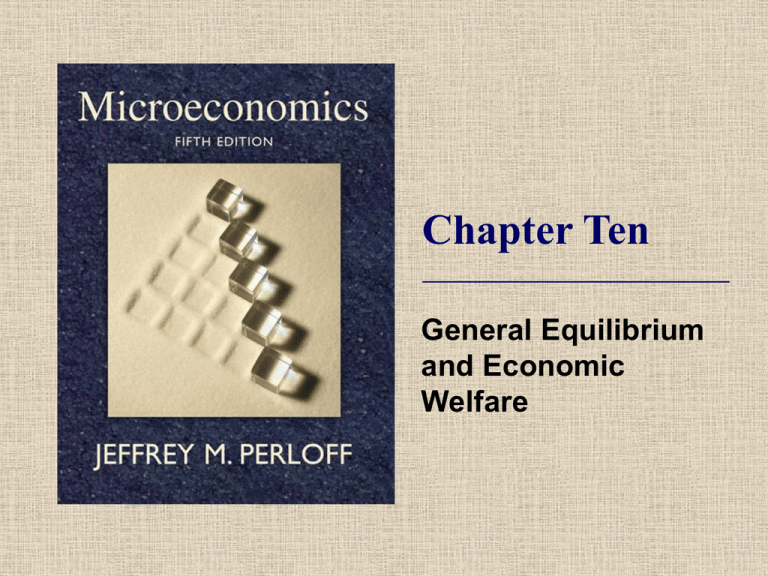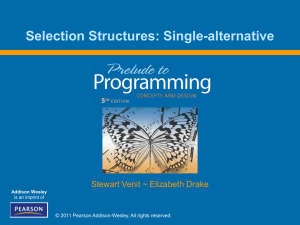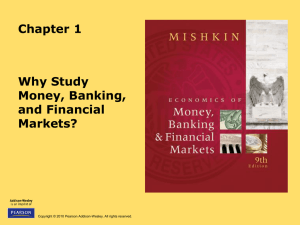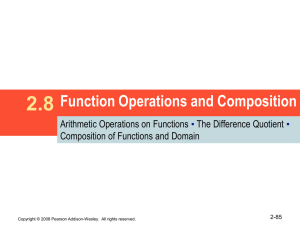
Chapter Ten
General Equilibrium
and Economic
Welfare
Topics
General Equilibrium.
Trading Between Two People.
Competitive Exchange.
Production and Trading.
Efficiency and Equity.
© 2009 Pearson Addison-Wesley. All rights reserved.
10-2
General Equilibrium
partial-equilibrium analysis - an
examination of equilibrium and changes
in equilibrium in one market in isolation.
general-equilibrium analysis - the
study of how equilibrium is determined
in all markets simultaneously
© 2009 Pearson Addison-Wesley. All rights reserved.
10-3
Feedback Between Competitive
Markets
Corn and soybean markets using supply
and demand curves estimated by Holt
(1992).
© 2009 Pearson Addison-Wesley. All rights reserved.
10-4
c
S0
c
S3
c
e0
$2.15
c
D0
c
e1
$1.9171
$1.9057
c
e3
c
D1
8.227 8.2613
8.44
Corn, Billionbushels peryear
(b) Soybean Market
Price, $ per bushel
Figure 10.1
Relationship
Between the
Corn and
Soybean
Markets
if demand for
corn decreased
….
Price, $ per bushel
(a) Corn Market
s
S0
s
e0
$4.12
s
D0
s
S2
s
S4
s
$3.8325
$3.8180
e2
s
e4
s
D2
s
D4
2.0505 2.0514
© 2009 Pearson Addison-Wesley. All rights reserved.
2.07
Soybeans, Billionbushels peryear
Table 10.1 Adjustment in the Corn
and Soybean Markets
© 2009 Pearson Addison-Wesley. All rights reserved.
10-6
Minimum Wages with Incomplete
Coverage
Result of partial-equilibrium analysis in
Chapter 2:
the minimum wage causes the quantity of
labor demanded to be less than the
quantity of labor supplied.
Workers who lose their jobs cannot find work
elsewhere, so they become unemployed.
© 2009 Pearson Addison-Wesley. All rights reserved.
10-7
Minimum Wages with Incomplete
Coverage (cont).
The story changes substantially if the
minimum wage law covers workers in
only some sectors of the economy.
When the U.S. minimum wage law was
first passed in 1938 it drove workers out
of manufacturing and other covered
industries into agriculture, which the law
did not cover. Why?
© 2009 Pearson Addison-Wesley. All rights reserved.
10-8
(a) Covered Sector
(b) Uncovered Sector
(c) Total Labor Market
w, Wage per hour
w, Wage per hour
w, Wage per hour
Figure 10.2 Minimum Wage with
Incomplete Coverage
w
–
S
Su
w1
w1
w2
Dc
Lc2
Lc1
L c , Annual hours
© 2009 Pearson Addison-Wesley. All rights reserved.
w1
Du
Lu1 Lu2
L u , Annual hours
D
L1 = Lc1 + Lu1
L, Annual hours
10-9
Solved Problem 10.1
After the government starts taxing the
cost of labor by τ per hour in a covered
sector only, the wage that workers in
both sectors receive is w, but the wage
paid by firms in the covered sector is w +
τ. What effect does the subsidy have on
the wages, total employment, and
employment in the covered and
uncovered sectors of the economy?
© 2009 Pearson Addison-Wesley. All rights reserved.
10-10
Solved Problem 10.1
© 2009 Pearson Addison-Wesley. All rights reserved.
10-11
Trading Between Two People: Scenario
Jane and Denise live near each other in
the wilds of Massachusetts when a
snowstorm strikes, isolating them from
the rest of the world.
They must either trade with each other or
consume only what they have at hand.
Collectively, they have 50 cords of
firewood and 80 bars of candy and no
way of producing more of either good.
© 2009 Pearson Addison-Wesley. All rights reserved.
10-12
Trading Between Two People:
Endowments
Endowment - an initial allocation of
goods
Jane’s endowment is 30 cords of
firewood and 20 candy bars.
Denise’s endowment is 20 (= 50 − 30)
cords of firewood and 60 (= 80 − 20)
candy bars.
So Jane has relatively more wood, and
Denise has relatively more candy.
© 2009 Pearson Addison-Wesley. All rights reserved.
10-13
Figure 10.3a Endowments in an
Edgeworth Box
© 2009 Pearson Addison-Wesley. All rights reserved.
10-14
Figure 10.3b Endowments in an
Edgeworth Box
© 2009 Pearson Addison-Wesley. All rights reserved.
10-15
Figure 10.3c Endowments in an
Edgeworth Box
© 2009 Pearson Addison-Wesley. All rights reserved.
10-16
Mutually Beneficial Trades
Four assumptions about their tastes and
behavior:
Utility maximization.
Usual-shaped indifference curves.
Nonsatiation.
No interdependence.
© 2009 Pearson Addison-Wesley. All rights reserved.
10-17
Figure 10.4 Contract Curve
© 2009 Pearson Addison-Wesley. All rights reserved.
10-18
Mutually Beneficial Trades
We can make four equivalent
statements about allocation f:
1. The indifference curves of the two parties
are tangent at f.
2. The parties’ marginal rates of substitution
are equal at f.
3. No further mutually beneficial trades are
possible at f.
4. The allocation at f is Pareto efficient: One
party cannot be made better off without
harming the other.
© 2009 Pearson Addison-Wesley. All rights reserved.
10-19
Contract Curve
contract curve - the set of all Paretoefficient bundles
© 2009 Pearson Addison-Wesley. All rights reserved.
10-20
Solved Problem 10.2
Are allocations a and g in Figure 10.4
part of the contract curve?
© 2009 Pearson Addison-Wesley. All rights reserved.
10-21
Competitive Exchange
Two desirable properties:
The competitive equilibrium is efficient.
First Theorem of Welfare Economics
Any efficient allocations can be
achieved by competition.
Second Theorem of Welfare Economics
© 2009 Pearson Addison-Wesley. All rights reserved.
10-22
Competitive Equilibrium
If there were a large number of people
with tastes and endowments like Jane’s
and a large number of people with
tastes and endowments like Denise’s,
each person would be a price taker in
the two goods.
© 2009 Pearson Addison-Wesley. All rights reserved.
10-23
Figure 10.5a Competitive Equilibrium
© 2009 Pearson Addison-Wesley. All rights reserved.
10-24
Figure 10.5b Competitive
Equilibrium
© 2009 Pearson Addison-Wesley. All rights reserved.
10-25
Competitive Equilibrium (cont).
In a competitive market, prices adjust
until the quantity supplied equals the
quantity demanded.
© 2009 Pearson Addison-Wesley. All rights reserved.
10-26
The Efficiency of Competition
In a competitive equilibrium:
pc
MRS j
MRS d
pw
Thus, we have demonstrated the First Theorem
of Welfare Economics:
Any competitive equilibrium is Pareto efficient.
© 2009 Pearson Addison-Wesley. All rights reserved.
10-27
Obtaining Any Efficient Allocation
Using Competition
Any Pareto-efficient bundle x can be obtained
as a competitive equilibrium if the initial
endowment is x.
That allocation can also be obtained as a
competitive equilibrium if the endowment lies
on a price line through x, where the slope of
the price line equals the marginal rate of
substitution of the indifference curves that are
tangent at x.
Thus, …..
© 2009 Pearson Addison-Wesley. All rights reserved.
10-28
Obtaining Any Efficient Allocation
Using Competition
we’ve demonstrated the Second
Theorem of Welfare Economics:
Any Pareto-efficient equilibrium can b
obtained by competition, given an
appropriate endowment.
© 2009 Pearson Addison-Wesley. All rights reserved.
10-29
Comparative Advantage
Scenario: Jane and Denise can produce
candy or chop firewood using their own
labor. They differ, however, in how much
of each good they produce from a day’s
work.
© 2009 Pearson Addison-Wesley. All rights reserved.
10-30
Production Possibility Frontier.
Jane can produce either 3 candy bars or
6 cords of firewood in a day.
Denise can produce up to 3 cords of
wood or 6 candy bars in a day.
© 2009 Pearson Addison-Wesley. All rights reserved.
10-31
Production Possibility Frontier (cont).
Production Possibility Frontier shows the maximum combinations of
two goods that can be produced from a
given amount of input.
The slope of the production possibility
frontier is the marginal rate of
transformation (MRT).
© 2009 Pearson Addison-Wesley. All rights reserved.
10-32
Figure 10.6 Comparative Advantage
and Production Possibility Frontiers
© 2009 Pearson Addison-Wesley. All rights reserved.
10-33
Production Possibility Frontier (cont).
comparative advantage - the ability to
produce a good at a lower opportunity
cost than someone else.
Because of the difference in their
marginal rates of transformation, Jane
and Denise can benefit from a trade.
© 2009 Pearson Addison-Wesley. All rights reserved.
10-34
Solved Problem 10.3
How does the joint production possibility
frontier in panel c of Figure 10.6 change
if Jane and Denise can also trade with
Harvey, who can produce 5 cords of
wood, 5 candy bars, or any linear
combination of wood and candy in a
day?
© 2009 Pearson Addison-Wesley. All rights reserved.
10-35
Solved Problem 10.3
© 2009 Pearson Addison-Wesley. All rights reserved.
10-36
Figure 10.7 Optimal Product Mix
© 2009 Pearson Addison-Wesley. All rights reserved.
10-37
The Number of Producers
Because the PPF is concave, the marginal rate
of transformation decreases (in absolute value)
as we move up the PPF.
Also,
MCc
MRT
MC w
where MCc and MCw are the marginal costs of
producing candy and wood respectively.
© 2009 Pearson Addison-Wesley. All rights reserved.
10-38
Efficient Product Mix
If a single person were to decide on the
product mix, that person would pick the
allocation of wood and candy along the
PPF that maximized his or her utility.
For each consumer:
MRS = MRT,
if the economy is to produce the optimal
mix of goods for each consumer.
© 2009 Pearson Addison-Wesley. All rights reserved.
10-39
Competition
Each consumer picks a bundle of goods so,
Pc
MRS
Pw
consumption efficiency - we can’t redistribute
goods among consumers to make one consumer
better off without harming another one.
the competitive equilibrium lies on the contract curve.
© 2009 Pearson Addison-Wesley. All rights reserved.
10-40
Competition (cont)
If candy and wood are sold by competitive firms,
pc = MCc
pw = MCw
Therefore,
Pc MCc
Pw MC w
MRT
Pc
Pw
Pc
MRT
MRS
Pw
© 2009 Pearson Addison-Wesley. All rights reserved.
10-41
Competition (cont)
Since,
Pc
MRT MRS
Pw
a competitive equilibrium achieves an:
efficient product mix - the rate at which firms can
transform one good into another equals the rate at
which consumers are willing to substitute between the
goods, as reflected by their willingness to pay for the
two goods.
© 2009 Pearson Addison-Wesley. All rights reserved.
10-42
Figure 10.8 Competitive
Equilibrium
© 2009 Pearson Addison-Wesley. All rights reserved.
10-43
Role of the Government
By altering the efficiency with which
goods are produced and distributed and
the endowment of resources,
governments help determine how much
is produced and how goods are
allocated.
© 2009 Pearson Addison-Wesley. All rights reserved.
10-44
Application Wealth Distribution in the
United States
© 2009 Pearson Addison-Wesley. All rights reserved.
10-45
Application Wealth Distribution in the
United States (a)
© 2009 Pearson Addison-Wesley. All rights reserved.
10-46
Application Wealth Distribution in the
United States (b)
© 2009 Pearson Addison-Wesley. All rights reserved.
10-47
Efficiency
The Pareto criterion ranks allocation x over
allocation y if some people are better off at x
and no one else is harmed.
If that condition is met, we say that x is Pareto
superior to y.
Any policy change that leads to a Paretosuperior allocation must increase W (welfare).
However, some policy changes that increase W
are not Pareto superior: There are both winners
and losers.
© 2009 Pearson Addison-Wesley. All rights reserved.
10-48
Equity
social welfare function - combines
various consumers’ utilities to provide a
collective ranking of allocations.
Sort of like a utility function for society.
Utility possibility frontier (UPF): the set
of utility levels corresponding to the
Pareto efficient allocations along the
contract curve.
© 2009 Pearson Addison-Wesley. All rights reserved.
10-49
Figure 10.9 Welfare Maximization
© 2009 Pearson Addison-Wesley. All rights reserved.
10-50
Application An Unequal World
© 2009 Pearson Addison-Wesley. All rights reserved.
10-51
Voting
Sometimes voting does not work well,
and the resulting social ordering of
allocations is not transitive.
© 2009 Pearson Addison-Wesley. All rights reserved.
10-52
Table 10.2 Preferences over
Allocations of Three People
© 2009 Pearson Addison-Wesley. All rights reserved.
10-53
Arrow’s Impossibility Theorem.
A social welfare function should satisfy the following
criteria:
Social preferences should be complete and transitive, like
individual preferences.
If everyone prefers Allocation a to Allocation b, a should be
socially preferred to b.
Society’s ranking of a and b should depend only on
individuals’ ordering of these two allocations, not on how they
rank other alternatives.
Dictatorship is not allowed; social preferences must not
reflect the preferences of only a single individual.
© 2009 Pearson Addison-Wesley. All rights reserved.
10-54
Arrow’s Impossibility Theorem (cont).
It is impossible to find a social decisionmaking rule that always satisfies all of
these criteria.
Result indicates that democratic decision
making may fail—not that democracy must
fail.
© 2009 Pearson Addison-Wesley. All rights reserved.
10-55
Social Welfare Functions
Utilitarian philosophers: suggested that
society should maximize the sum of the
utilities of all members of society.
Their social welfare function is the sum of
the utilities of every member of society.
If Ui is the utility of Individual i and there
are n people, the utilitarian welfare
function is:
W = U1 + U2 + . . . + Un.
© 2009 Pearson Addison-Wesley. All rights reserved.
10-56
Social Welfare Functions (cont).
The Rawlsian welfare function is:
W = min {U1, U2, . . . , Un}.
Rawls’ rule leads to a relatively egalitarian
distribution of goods.
© 2009 Pearson Addison-Wesley. All rights reserved.
10-57
Cross-Chapter Analysis: Outsourcing
and the World Trade Organization
© 2009 Pearson Addison-Wesley. All rights reserved.
10-58








